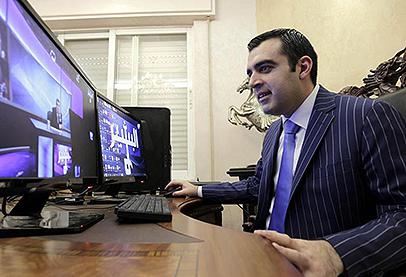Can Arab satellite TV catch up with social media?

What do Arab audiences expect from social media platforms on the one hand and from satellite TV stations on the other?
By their very nature, social media platforms have come closer to their users and given them the means for private use: audio, video and text communication, video clips and live streaming, which emulates satellite TV but without forcing content on viewers. These platforms are spoiling their users by offering them choice of content and unprecedented opportunities to express themselves and reach thousands of other users.
An average user can share his or her own views on a wide scale. It has become possible for average users to reach out to well-known figures.
Satellite TV stations are acutely aware of their inherent limitations in direct contact with audiences. TV personalities and journalists often appear on television, present their shows and then disappear from public view.
To bridge the gap separating them from social media platforms, many TV channels are posting tweets, text messages or Facebook comments by audience members in real time. However, what is missing from these TV channels is a platform for immediate and wide interaction with audiences interested in seeing their views expressed live. Some channels do show text and audio messages from their audiences in running strips along the bottom of the screen.
What can TV stations do? Of course, there are Arab TV outlets that have avoided the problems of interacting with their audiences by offering specialised content, such as dramas, sports, films or programmes for women.
Reliable data regarding satellite TV audiences in the Arab world are at best incomplete. Interactive platforms, on the other hand, are equipped to provide data for each site, page and post instantly, clearly visible to everybody. Arab media are facing unprecedented challenges brought about by interactive technologies, challenges that will require creative solutions.
Regarding satellite TV stations, one cannot help but wonder what changes will be necessary for Arab TV channels to introduce. Changes must be made to update their visual and presentation styles as well as their interactive technologies. These TV channels and stations must keep up with fast-developing technological innovations if they want to better interact with their audience and thus survive.
In the 1980s, feedback technology was introduced and quickly became popular in the media to directly sound audience opinions and reactions to news and for reporting the news. The role of feedback in the news is being taken over by social media platforms, which provide an immediate way to express feedback.
As soon as a TV show or programme is over, reactions start pouring in on Twitter and Facebook. The phenomenon resembles an informal poll but is nevertheless real and deserves attention from TV channels. It has become commonplace for TV channels to glean audience reactions from social media platforms.
Taher Alwan is an Iraqi writer.
This article was originally published in The Arab Weekly.





